Thousands of computer games are commercially available on a variety of hardware configurations. These games present a bewildering array of properties. Many show close similarities. Most possess some unique design feature. Given this large sample of games, we can learn a great deal about game design by establishing a taxonomy of computer games. A taxonomy would illuminate the common factors that link families of games, while revealing critical differences between families and between members of families. A well-constructed taxonomy will often suggest previously unexplored areas of game design. Most important, a taxonomy reveals underlying principles of game design. In another field of study, Charles Darwinís meticulous taxonometric work while on the Beagle led almost inevitably to his development of the theory of evolution. While we cannot hope that taxonometric work in computer game studies will be so spectacularly productive, it certainly seems worth the effort.
I will insist on an important qualification: I do not claim that the taxonomy I propose is the correct one, nor will I accept the claim that any correct taxonomy can be formulated. A taxonomy is only a way of organizing a large number of related objects. If there were some organizing agent, some underlying process that created the group of objects, then we could reasonably expect to be able to find a single correct taxonomy embodying the central organizing principle in its structure. For example, the wide array of living creatures on this earth did not arise by chance; this array is the product of natural selection. Natural selection is a reasonable, understandable, nonarbitrary process. Therefore, there is only one reasonable taxonomy for life on earth, the taxonomy that embodies the principles of natural selection. In the shape of an airplane we can see the principles of aerodynamics; so too in a taxonomy of living creatures can we see the hand of natural selection.
Such is not the case with computer games. The field is too young, the sample too small, for whatever organizing principles there may be to have asserted themselves. The games we now have are more the product of happenstance than the inevitable result of well-established forces. Without a wide array of games there is little opportunity to choose between games; without choice there can be no natural selection. It is therefore impossible for us to devise a single, absolute taxonomy. Many taxonomies are admissible. Indeed, attempting to construct several alternative taxonomies is a useful way to examine the common traits of computer games. I am not so ambitious; I shall be happy to propose just one taxonomy. I divide computer games into two broad categories: skill-and-action ("S&A") games (emphasizing perceptual and motor skills) and strategy games (emphasizing cognitive effort). Each major category has several subcategories. Top
This is easily the largest and most popular class of computer games. Indeed, most people associate all computer games with skill-and-action games. All arcade games are S&A games and almost all games for the ATARI 2600 are S&A games. This class of games is characterized by real-time play, heavy emphasis on graphics and sound, and use of joysticks or paddles rather than a keyboard. The primary skills demanded of the player are hand-eye coordination and fast reaction time.
I group skill-and-action games into six categories: combat games, maze games, sports games, paddle games, race games, and miscellaneous games. Top
Combat games all present a direct, violent confrontation. The human player must shoot and destroy the bad guys controlled by the computer. The challenge is to position oneself properly to avoid being hit by the enemy while shooting him. These games are immensely popular; they are Atariís forte. There are many variations on this theme, most arising from variations on the geometry of the situation or the weaponry of the opponents.
STAR RAIDERS and SPACEWAR can be compared on these bases of geometry and weaponry. In both games the player files through space in a rocket ship and engages enemy spaceships in real-time cosmic dogfights. STAR RAIDERS presents the conflict in first-person geometry (that is, the television screen shows the same scene that the pilot would see.) SPACEWAR uses much the same weaponry and mechanisms with one crucial difference: the geometry of the game is third-person rather than first-person (that is, the player sees his own and his opponentís spaceships from a distance.) The difference in result is obvious to anyone who has played both games. The first-person game is more exciting and compelling than the third-person game. Unfortunately, the first-person geometry is so technically difficult to execute that it has been implemented on only a few games. Most games use third-person geometry.
ASTEROIDS is a shoot-em-up game that uses the same space environ that STAR RAIDERS uses. The primary difference between the two games is in the nature of the opposition. The enemy in ASTEROIDS is not a small number of intelligent opponents armed with weapons identical to the playerís; instead, the enemy is a large number of stupid rocks armed only with their ability to destructively collide with the player.

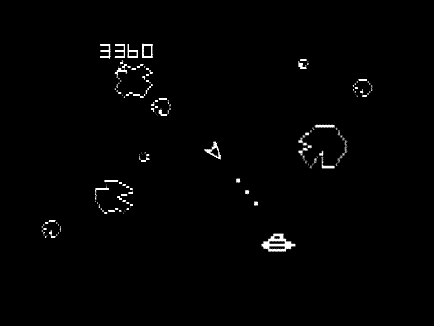
MISSILE COMMAND is another combat game with several interesting twists. First, the player must defend not only himself but also his cities from descending nuclear bombs. Second, the game is a purely defensive game in that the player never has the opportunity to attack his enemy. Third, while shots in other games are very rapid events, the shooting process in this game is slower and takes time to develop because the missiles must fly to their targets before detonating. Because the time between firing and impact is so long, the player must plan his shots with greater foresight and make use of multiple explosions. Thus, although this is a skill-and-action game, there are more strategic elements involved than in many games of this category.
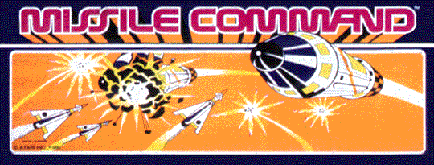
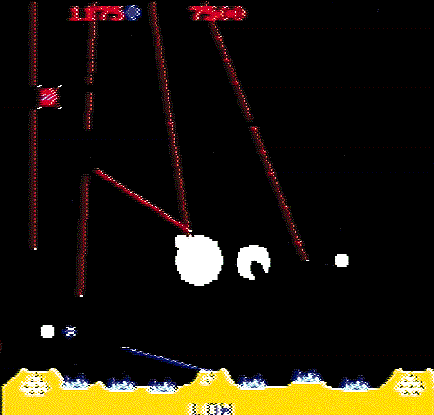
SPACE INVADERS (trademark of Taito America Corp.) is one of the most successful combat games of all time. It was one of the first smash hit games and contributed to the upsurge of popularity of computer games that began in 1979. While STAR RAIDERS and ASTEROIDS give the player great mobility and MISSILE COMMAND gives him none, SPACE INVADERS gives the player limited mobility in one dimension only. As in ASTEROIDS, the player must face a multitude of rather stupid opponents who can win by touching the player (landing); in addition, as in STAR RAIDERS, the monsters also shoot back. The monsters march back and forth across the screen, slowly descending onto the player. As the player kills more and more monsters, they march faster and faster. This gives the game a hypnotic accelerating tempo. SPACE INVADERS is definitely a classic.
The success of SPACE INVADERS has spawned a whole series of copies and derivatives. There are a large number of copies whose only goal was to cash in on the success of the original game. There are also several genuine derivative games. For example, GALAXIAN (trademark of Midway) is a simple variation on SPACE INVADERS. Individual invaders peel off and attack the player with more ferocity than the docile monsters of the original game. CENTIPEDE; is also a derivative of SPACE INVADERS; it is different enough to be a new design, but the internal game structure is very similar to the original. The invaders have been grouped into a segmented centipede; their side-to-side motion is bounded not by the edges of the screen but by mushrooms randomly scattered across the screen. Numerous embellishments (spiders, fleas, and scorpions) extend the game considerably. TEMPEST is a three-dimensional first-person derivative of SPACE INVADERS using vector graphics. The amount of design attention that SPACE INVADERS has attracted is a tribute to the gameís originality, appeal, and durability.

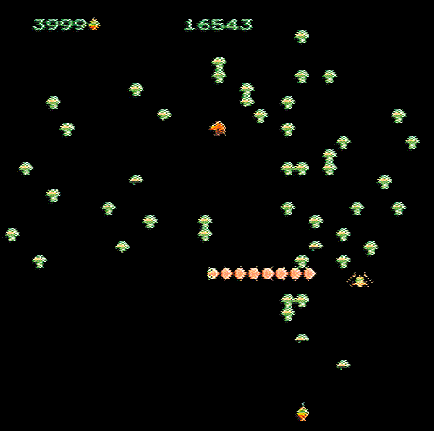
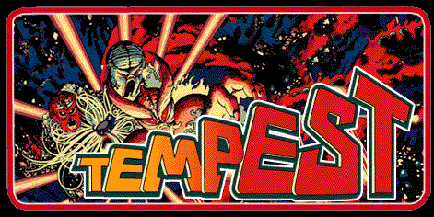
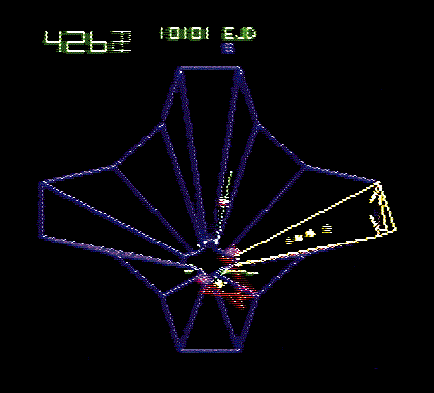
There are many, many other combat games. BATTLEZONE and RED BARON are two first-person combat games utilizing vector displays. Other combat games include CAVERNS OF MARS, YARíS REVENGE, CROSSFIRE (trademark of On-Line Systems) and DEFENDER (trademark of Williams).
You may wonder why so many combat games are set in outer space. There are three reasons. First, space is easy to depict and animate with a computer---all the designer need do is draw a blank screen with a few white dots for stars. Second, space is not encumbered by the expectations of the players. A designer encountering problems can always concoct some super-duper zapper to solve any design problems with the game and nobody can object that it is unrealistic. Earthbound games constrain the designer to look reality squarely in the eye---such a tiresome burden for a "creative" mind. Third, space is an intrinsically fantasy-laden environment that encourages suspension of disbelief because it is unfamiliar to its audience.
Combat games have always been at the heart of computer gaming. Players never seem to tire of them; it appears that they will be around for a long time to come. Top
The second subgrouping of S&A games is the set of maze games. PAC-MAN (trademark of Namco) is the most successful of these, although maze games predate PAC-MAN. The defining characteristic of the maze games is the maze of paths through which the player must move. Sometimes one or more bad guys pursue the player through the maze. Some maze games (MAZE CRAZE for the ATARI 2600 is a good example) specifically require that the player make his way to an exit. Other maze games require that the player move through each part of the maze. DODGE 'EM is an early example of such a game. In either case, the number, speed, and intelligence of the pursuers then determines the pace and difficulty of the game. PAC-MAN has a very carefully balanced combination of these factors. The pursuers are just slightly slower than the human player; their intelligence and number make up for this. The overall pace of the game makes it difficult for the player to fully analyze the positions of the five pieces in real time.
![]()
Any successful game is certain to attract copies, variations, and derivatives, and PAC-MAN is no exception. One of the first such games for the ATARI Home Computer System was the first edition of JAWBREAKERS (trademark of On-Line Systems). This game, now removed from the market, clearly demonstrates the difference between structural changes and cosmetic changes. Structurally, it is indistinguishable from PAC-MAN. The play of the game is almost identical to that of PAC-MAN. Cosmetically, there are a number of differences: the pursuers are faces rather than ghosts; the player is a set of teeth rather than a head with mouth; the maze is laid out differently; the sounds are different. This game provides a good example of the methods that can be used to copy games while attempting to minimize legal problems.
Another PAC-MAN derivative is MOUSKATTACK (trademark of On-Line Systems). This game shows some structural changes relative to PAC-MAN. The player is again pursued through a maze by four computer-controlled creatures, but the basic scenario contains a number of embellishments. First, merely passing through every point in the maze is not enough; some points, randomly chosen by the computer, must be passed through twice. Second, the player is allowed to fight back against the pursuers in a very different way (setting mousetraps). The strategic and tactical effects of this counterforce capability yield a game that plays rather differently. Finally, there is a very interesting two-player game that allows both cooperative and competitive strategies. In MOUSKATTACK we see the basic structure of PAC-MAN with a number of embellishments and extensions that produce a distinct game.
The appeal of maze games can be attributed to the cleanliness with which they encapsulate the branching structure that is a fundamental aspect of all games. The reader will remember from Chapter One that a game has a tree structure with each branch point representing a decision made by the player. In a maze game, each branch point is neatly depicted by an intersection in the maze, and the options available to the player are visually presented as the paths available at the intersection. Thus, a maze game presents a clear visual representation of the branching structure of the game.
Even more fascinating is the looping structure possible with maze games. A player can return to an intersection in the maze many times. Yet, each time he does so, the options he has take different meanings because the other maze-inhabitants have moved in the interim to a different pattern of positions. In this way, a small number of displayed intersections can represent a huge number of branch-points in the game-tree. The analogy with a computer program, in which a small number of program instructions, through looping and branching, can address a large number of specific cases, is striking. Top
These games model popular sports games. They are anachronisms derived from the early days of computer game design when computer games had no identity of their own. People without original ideas for games fell back on the sports games as models around which to design. This also served a useful marketing purpose: why would a conservative consumer buy a game with a title and subject completely alien to his experience? Better to offer him a game he is already familiar with. Thus we have games based on basketball, football, baseball, soccer, tennis, boxing, and others. All of these games take liberties with their subject matter to achieve playability. The most enjoyable aspects of the computer game have very little to do with the real game. This is fortunate, for a slavish attempt at replication would have produced a poor computer game. Only by substantially altering the original games were the authors able to produce a decent design. Even so, sports games remain the wallflowers of computer gaming. I suspect that sports games will not attract a great deal of design attention in the future. Now that computer games have an accepted identity of their own, the need for recognizable game titles has diminished. Top
I use the title "Paddle Games" to cover the PONG-based games. PONG is certainly one of the most successful and fertile of game designs, for it has many grandchildren and great-grandchildren. The central element of the game, that of intercepting a projectile with a paddle-controlled piece, has been used in endless variations. The original PONG pitted two players in an electronic version of ping-pong, hence the name. BREAKOUT was a solitaire version that required the player to chip away at a wall with the ball. The player received points for each brick destroyed. SUPERBREAKOUT introduced variations on this theme with moving walls, extra balls, and other tricks. CIRCUS ATARI introduced parabolic trajectories for the projectiles and a complex moving wall of balloons. WARLORDS; took the genre even further; up to four players (one in each corner) defend brick castles against a projectile bounced around the field by their shield-paddles.
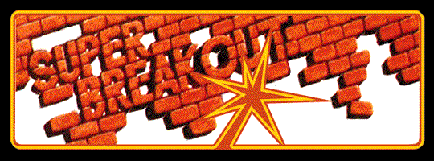
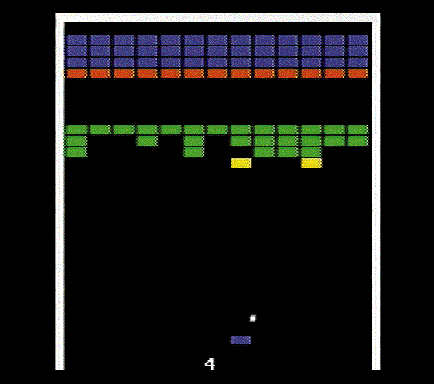
In the above games, the player uses the ball as a weapon to batter; in other paddle games the player must only catch the ball, or many balls, rather than deflect it. AVALANCHE is one such game. In this game, the player is at the bottom of the screen and large numbers of rocks are failing; each one must be caught with the playerís piece. The game becomes quite frantic as more and more rocks fall at a faster and faster pace. Another game, CHICKEN, (trademark of Synapse Software) expands on this theme by replacing the rocks with eggs and making each one hatch on striking the ground, forcing the player-hen to jump over it as she moves about.
The paddle game-system is a very simple one; although I doubt that it has much development potential remaining, I am hesitant to pronounce such a durable old system dead. Top
Some computer games involve a straightforward race. Most of these games allow the player to move at constant speed, but extract time penalties for failure to skillfully negotiate an assortment of hazards. Thus, a player in the APX skiing game DOWNHILL must avoid the trees and rocks; the playerís score is based on his time to complete the course. MATCH RACER by Gebelli Software is a car-racing game with oil slicks and obstacles. NIGHT DRIVER is a car-racing game featuring a first-person view of the road. One problem with all of these games is that they are not true games but puzzles, for there is no real interaction in a race between a player and his opponent. Indeed, it is difficult to identify the opponent in these games.
A more involved variation on the race game is DOG DAZE by Grey Chang. This is a true game, not a puzzle. It presents a two-player competitive race game with variable goals and asymmetric obstacles. Each player has a dog; hydrants pop onto the screen at random locations; the players must race to be the first to touch the hydrant, thereby claiming it as their own. Players may not touch hydrants owned by their opponents on pain of being temporarily paralyzed. The game has many interesting twists and turns without being overly complex; it demonstrates that the race game can be a flexible vehicle of game design. Top
My taxonomy is flawed; there exist a number of games that do not fit into this taxonomy very well. The first I will mention is DONKEY KONG, (trademark of Nintendo) a game that looks vaguely like a race game with intelligent obstacles. FROGGER (trademark of ________) is another game that defies classification in this taxonomy. It could perhaps be called a maze game with moving walls or obstacles, but the fit is poor. APPLE PANIC by Broderbund Software also defies my taxonomy. In some ways it is like a maze game and in some ways it is a combat game. The pace of the game is oddly slow. I donít know what to call this game. The fact that these games do not fit my taxonomy does not bother me overly much; I certainly donít want to create ad hoc categories for individual games. I am content to wait and see other developments before I create new categories or revise old ones. Top
Strategy games comprise the second broad class of computer games. These games emphasize cogitation rather than manipulation. I do not mean to imply that S&A games are devoid of strategic content; some S&A games do indeed have a strategic element. The major distinguishing factor between strategy games and S&A games is the emphasis on motor skills. All skill-and-action games require some motor skills; strategy games do not. Indeed, real-time play is rare in strategy games (this is changing; LEGIONNAIRE from Avalon-HIII is a notable real-time strategy game). Strategy games typically require more time to play than S&A games. Strategy games are nonexistent in the arcades; they are rare on the ATARI 2600; they are almost exclusively restricted to personal computers. I divide strategy games into six categories: Adventures, D&D games, wargames, games of chance, educational games, and interpersonal games. Top
These games derive from one of the oldest computer games, called "Adventure". In these games the adventurer must move through a complex world, accumulating tools and booty adequate for overcoming each obstacle, until finally the adventurer reaches the treasure or goal. Scott Adams created the first set of Adventures widely available for personal computers; his software house (Adventure International) is built on those games. The Scott Adams games are pure text adventures that run in a small amount of memory, so they do not need disk drives; they are also readily transportable to different machines. A short time later Ken and Roberta Williams built On-Line Systems with THE WIZARD AND THE PRINCESS (trademark of On-Line Systems), an adventure that presented pictures of the scenes in which the adventurer found himself. The game itself was not particularly new; the innovation was primarily the use of graphics. Both firms have expanded their lines with more games using the systems they pioneered. Most of these derivative games are structurally similar to the originals, differing in detail, polish, and size.
The next variation on the adventure theme was the giant adventure, of which there are several. TIME ZONE by On-Line Systems is one of these. These giant adventures use multiple diskettes to link together a gigantic adventure. As the player solves the puzzle in one environment he moves on to another environment on another disk. The games are structurally identical to earlier games; the only difference is one of magnitude. They take many weeks of play to solve.
A new variation on the adventure game genre is DEADLINE (trademark of Infocom), a detective adventure with a number of interesting twists. Its heritage as an adventure is evident in its lack of graphics and its use of an excellent sentence parser. This adventure puts the player in the role of a detective attempting to solve a murder. The game is played in a real-time mode that adds to the interest and challenge of the game. The player searches not for treasure but for information with which to solve the murder. This game shows the potential of the adventure system in that the same system can be used, with the storyline and goals altered, to appeal to a different audience.
One of the most clever adventures ever done is Warren Robinettís ADVENTURE on the ATARI 2600. This adventure follows the same basic format as all adventures, except that it uses absolutely no text. Instead, the user moves through a series of rooms presented in rather simple graphics. Although the graphics and input schemes are radically different, the basic feel of the adventure system has been successfully retained. SUPERMAN, HAUNTED HOUSE, and GALAHAD AND THE HOLY GRAIL by Doug Crockford are all derivatives of this game.
Adventures are closer to puzzles than to games. As discussed in Chapter One, puzzles are distinguished from games by the static nature of the obstacles they present to the player. Adventures present intricate obstacles that, once cracked, no longer provide challenge to the player. It is true that some adventures push closer to being games by incorporating obstacles such as hungry dragons that in some way react to the player. Nevertheless, they remain primarily puzzles. Top
A completely independent thread of development comes from the D&D style games. Fantasy role-playing was created by Gary Gygax with Dungeons and Dragons (trademark of TSR Hobbles), a complex noncomputer game of exploration, cooperation, and conflict set in a fairytale world of castles, dragons, sorcerers, and dwarves. in D&D, a group of players under the guidance of a "dungeonmaster" sets out to gather treasure. The game is played with a minimum of hardware; players gather around a table and use little more than a pad of paper. The dungeonmaster applies the rules of the game structure and referees the game. The dungeonmaster has authority to adjudicate all events; this allows very complex systems to be created without the frustrations of complex rules. The atmosphere is quite loose and informal. For these reasons, D&D has become a popular game, with endless variations and derivatives.
D&D first appeared in the mid-70ís; it didnít take long for people to realize that it had two serious limitations. First, the game needed a group of players and a dungeonmaster, so it was impossible to play the game solitaire. Second, the game could sometimes become tedious when it required lengthy computations and throwing of dice. Many people recognized that these problems could be solved with a microcomputer. The first company to make a D&D style computer game available was Automated Simulations. Their TEMPLE OF APSHAI program has been very successful. They also market a number of other D&D-style games.
So far, however, few games have been marketed that truly capture the spirit of D&D. There are several reasons for this. First, most D&D-players are young and donít have the money for such packages. Second, the adventure games have slowly absorbed many of the ideas of the D&D games. There was a time when we could easily distinguish an adventure from a D&D game with several factors.Adventures were pure text games, while D&D games used some graphics. Adventures were puzzles; D&D games were true games. Adventures were by and large nonviolent, while D&D games tended to be quite violent. Lately, we have seen adventures taking on many of the traits of D&D games, so that it is now harder to tell the difference between them.
An ideal example of this phenomenon is ALI BABA AND THE FORTY THIEVES (trademark of Quality Software), a game with the basic elements of both adventures and D&D games. The player must search through a large maze to find and rescue a princess, but on the way he must fight monsters and thieves. The player, as Ali Baba, possesses personal characteristics (dexterity, speed, etc.) that are reminiscent of a D&D game, but he must explore the maze as in an adventure. For these reasons, I feel that this game cannot be classified as either an adventure or a D&D game, but rather is a solid example of the merging of these two genres into a new class of games, the fantasy role-playing ("FRP") games. This suggests that we will see more such games combining the "search and discover" aspects of adventure games with the "defeat opponents" aspects of D&D games. Top
A third class of strategy games is provided by the wargames. Noncomputer wargames as a gaming form have a long heritage. Commercial wargaming goes all the way back to the 1880ís with an American wargame design using wooden blocks. The British have long had a dedicated group of wargamers using miniature models of soldiers and very complex rules. Their games, called miniatures games, have grown in popularity and are now played in the USA. But the largest segment of wargamers in recent years has been the boardgamers. This hobby was founded in the late 1950ís by Charles Roberts, who founded the Avalon-Hill Game Company and created such classic games of the 60ís as BLITZKRIEG, WATERLOO, and AFRIKA KORPS (all trademarks of the Avalon-Hill Game Company). During the 1970ís a new company, Simulations Publications, Inc., turned board wargaming into the largest segment of wargaming.
Wargames are easily the most complex and demanding of all games available to the public. Their rules books read like contracts for corporate mergers and their playing times often exceed three hours. Wargames have therefore proven to be very difficult to implement on the computer; we have, nevertheless, seen entries.
The computer wargames available now fall into two distinct groups. The first group is composed of direct conversions of conventional boardgames. COMPUTER BISMARK, COMPUTER AMBUSH, and COMPUTER NAPOLEONICS (trademarks of Strategic Simulations, Inc.) are examples of this group of games. These games illustrate the folly of direct conversion of games of one form to another. They parrot successful and respected boardgames, but are themselves not as successful. Because they attempt to replicate boardgames, they are, like boardgames, slow and clumsy to play.
The second group of computer wargames are less slavish in their copying of board wargames. My own EASTERN FRONT 1941 is generally considered to be the best of this lot, primarily because of its graphics and human engineering features. Many of the games in this category are experimental; hence the successes are outnumbered by the failures. Avalon-Hillís first entries into the computer wargaming arena were such experiments. My own TANKTICS game is an early experiment that once was the most advanced commercially available wargame (it was the ONLY commercially available wargame when I first released it in 1978). It is now generally regarded as a mediocre game. It can safely be said that computer wargaming is not a well-developed area of computer gaming. For the moment, computer wargaming is too closely associated with board wargaming in the minds of the public and most designers; until it can shake free from the constraints of boardgames and, establish its own identity, computer wargaming will evolve slowly. Top

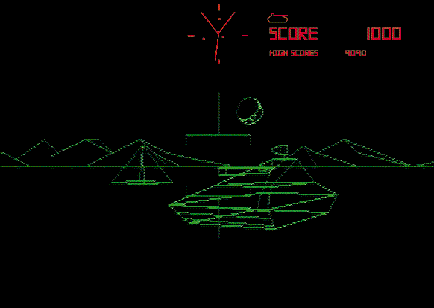
Games of chance have been played for thousands of years; their implementation onto computers is therefore quite expectable. They are quite easy to program, so we have seen many versions of craps, blackjack, and other such games. Despite their wide availability, these games have not proven very popular, most likely because they do not take advantage of the computerís strong points. Furthermore, they lose the advantages of their original technologies. These games demonstrate the folly of mindlessly transporting games from one medium to another.Top
Educational and Childrenís Games
The fifth category of strategy games is that of the educational games. Although all games are in some way educational, the games in this set are designed with explicit educational goals in mind. This group is not heavily populated as yet, perhaps because the people interested in educational uses of computers have not yet concentrated much attention on game design. The Thorne-EMI puzzles are good entries in this field, and APX sells a collection of very simple childrenís games that have some educational value. Several of the classic computer games are educational: HANGMAN, HAMMURABI, and LUNAR LANDER are the three most noteworthy of these early educational games. SCRAM (a nuclear power plant simulation) and ENERGY CZAR (an energy economics simulation) are two of the more complex programs in the educational games field. My favorite entry to date is ROCKYíS BOOTS (trademark of The Learning Company), a childrenís game about Boolean logic and digital circuits. The child assembles logic gates to create simulated logical machines. This game demonstrates the vast educational potential of computer games. Educators are becoming more aware of the motivational power of computer games; with time we can expect to see more entries of the caliber of ROCKYíS BOOTS.Top
I have been exploring a class of games that focus on the relationships between individuals or groups. One such game explores gossip groups. The player exchanges gossip with up to seven other computer-controlled players. The topic of conversation is always feelings, positive or negative, expressed by one person for another. Adroit posturing increases popularity. Similar games could address corporate politics, soap-opera situations, gothic romances, international diplomacy, and espionage. Although the category is undeveloped, I believe it is important because it addresses fantasies that are very important to people. Many other art forms devote a great deal of attention to interpersonal relationships. It is only a matter of time before computer games follow a similar course. Top
This concludes the description of my proposed taxonomy. Obviously, this taxonomy has many flaws. This is primarily because the basis of division is not any grand principle but is instead historical happenstance. There is no fundamental reason why wargames should be treated any differently than D&D games. Yet, both game systems evolved separately and are historically quite distinct. Similarly, the creation of an educational games category is my response to the efforts of educators to create educational games. With the passage of time, market forces will assert themselves, and a more organized and consistent taxonomy will become possible. People have tried to create educational games, so we now have them. My taxonomy is a patchwork because the set of available computer games is a patchwork.
 This
taxonomy suggests a number of observations about the state of game design
with computers. For example, it should be obvious that there are very few
basic scenarios for skill-and-action games, each scenario taking one category.
The archetypical game in each category spawned a whole family of imitators,
variations, and improvements. Moreover, the archetypical game in each category
was seldom the big moneymaker; instead, the archetypical game was followed
by several successor games that improved on it until one game hit the nail
on the head. Thus we have COMBAT leading to SPACE INVADERS in the combat
category, DODGE 'EM leading to PAC-MAN in the maze category, and PONG leading
to SUPERBREAKOUT in the paddle category.
This
taxonomy suggests a number of observations about the state of game design
with computers. For example, it should be obvious that there are very few
basic scenarios for skill-and-action games, each scenario taking one category.
The archetypical game in each category spawned a whole family of imitators,
variations, and improvements. Moreover, the archetypical game in each category
was seldom the big moneymaker; instead, the archetypical game was followed
by several successor games that improved on it until one game hit the nail
on the head. Thus we have COMBAT leading to SPACE INVADERS in the combat
category, DODGE 'EM leading to PAC-MAN in the maze category, and PONG leading
to SUPERBREAKOUT in the paddle category.
Another lesson that arises from this taxonomy is that the Analogy games are still in a very poorly-developed state in comparison to the S&A games. While S&A games have fairly clear-cut categories that make sense, the categories in strategy games are less satisfying and the distinctions between categories are muddier. This ambiguity suggests that much creative opportunity remains in the strategy games field.
A taxonomy reflects the body of material it attempts to organize. The state of computer game design is changing quickly. We would therefore expect the taxonomy presented here to become obsolete or inadequate in a short time. New taxonomies must be created to reflect the changes in the marketplace in the next few years. For the present, however, the proposed taxonomy can provide us with an organized way to view the menagerie of games while suggesting new areas to explore.